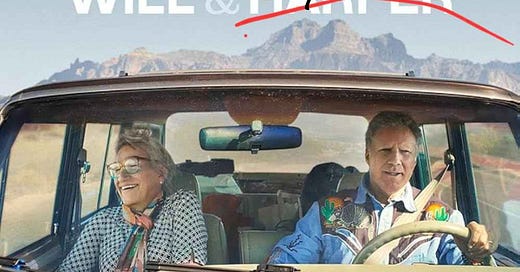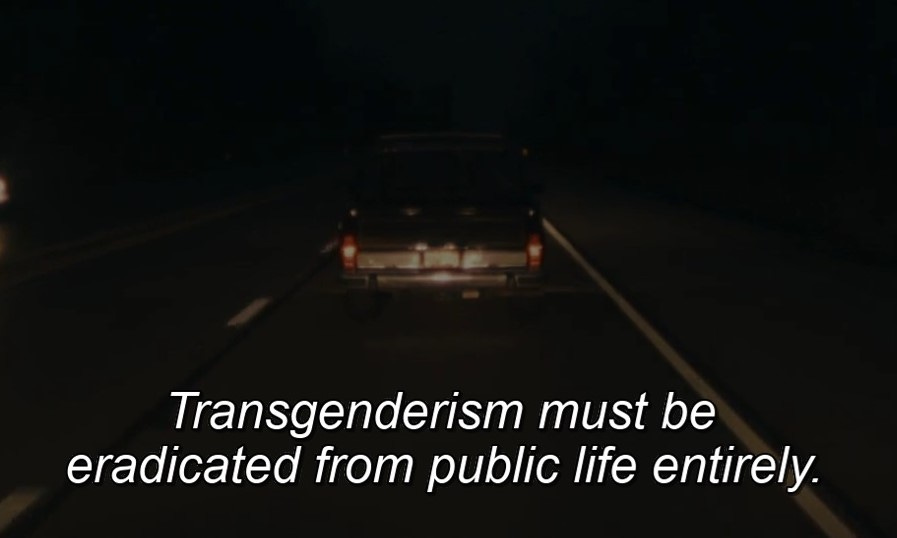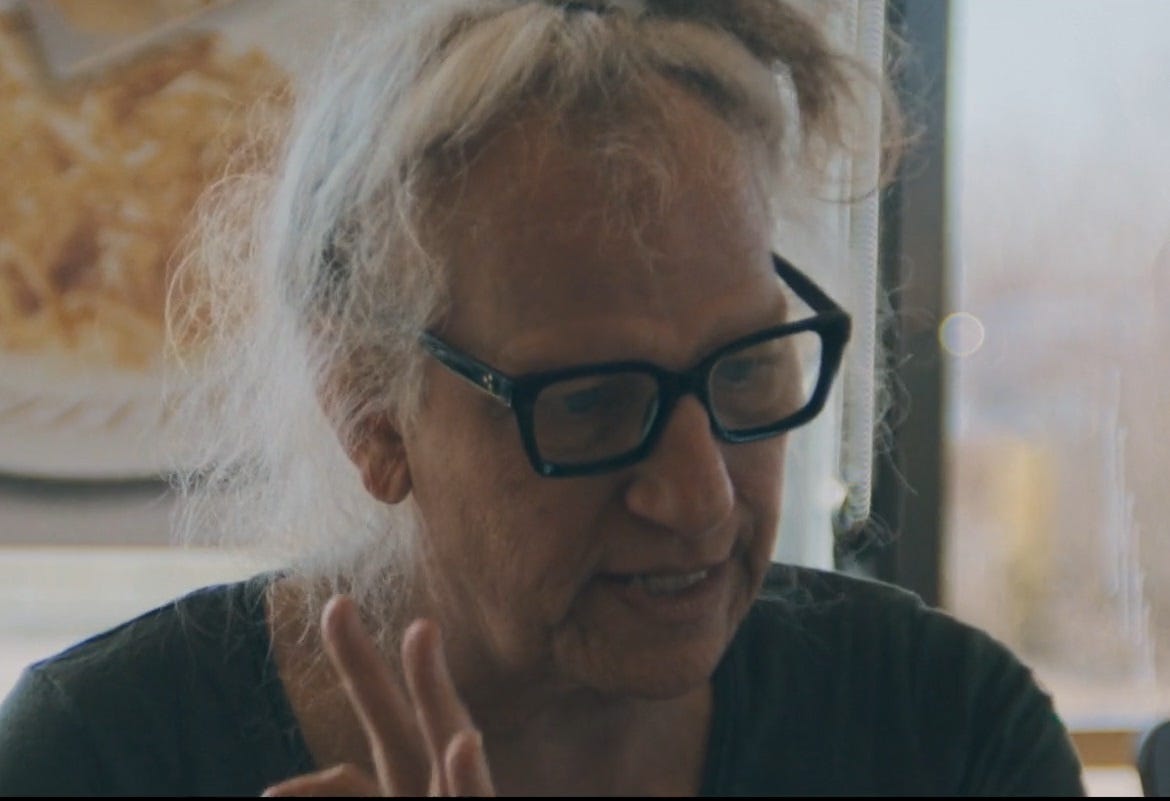Rejecting Will and Andrew
A Repudiation of Netflix’s Newest Bit of Transgender Propaganda, Will & Harper
Author’s Note: There are some “spoilers,” such as they are in this essay. This author strongly recommends against viewing this production. Indeed, one purpose in writing this essay is to impart information to readers so that they do not need to watch, even for the purposes of knowing one’s enemy. If one decides to watch this, it is highly advised to either watch it via a friend’s Netflix subscription or by. . . other means. Do not feed the machine.
As many are well aware, Netflix recently released what it touts as a “documentary,” Will & Harper. The film, if one can call it that, features comedian and actor Will Ferrell and “Harper” Steele, real name Andrew Steele, a friend and longtime colleague of Ferrell who started writing for Saturday Night Live the same year Ferrell joined the cast. “Harper” recently “came out” as transgender, and the film begins by summarizing the correspondence between the two arising from Steele “coming out.” When Steele wrote Ferrell with the announcement, the two men had not seen each other in some time, in part because of Covid, before the two meet face-to-face for the first time in several years. Steele had spent many years going on road trips, perusing middle America. Now that he presents himself as a woman, he is afraid or deterred from doing so as “Harper.” For that reason, Ferrell agrees to go with him on a coast-to-coast road trip.
Despite being touted as such, the film hardly qualifies as a documentary at all. No portion of the film includes information that the creators want to impart to their viewers. This piece best fits in the reality television genre, condensed into 140 minutes of running time, a little long for a two-hour special or four-part miniseries in thirty-minute increments. Aside from conveying an utterly pernicious message, the film, if one can call it that, is often quite boring and, as with most television and movies over the past few years, needed to be edited down. Perhaps the most striking feature of this work is how it uses music to affect the mood of its viewers. Much of the music sets a tone of overt sentimentality. Some of it is borderline childish. Halfway through the film, after having met with the governor of Indiana, Eric Holcomb, during an appearance at an Indiana Pacers game, there is a montage of news announcers describing “anti-transgender” laws, set to ominous, foreboding music. None of the laws go nearly far enough, simply prohibiting so-called “gender affirming care” to minors. The last excerpted portion of the montage features this statement: “Transgenderism must be eradicated from public life entirely,” a correct and sensible view that more people need to take.
There are some particular details divulged in this which should be of interest to readers. Steele’s wife divorced him in conjunction with his transition, although the exact particulars are not made clear. The “documentary” does not mention her name, nor does it indicate for how long they were married. Before driving south to Washington, DC, before heading west, the pai meet with Steele’s two daughters, who are young adults. One could be mistaken for a young man if a viewer is less than attentive. Both are supportive, and give lip service to the transgender jargon all too familiar to too many. Quite critically, it was revealed that Stelle started wearing women’s close contemporaneous with his divorce. It is not entirely clear but it seems it happened just before the divorce. This detail matters because it reveals how Steele’s transgender lunacy destroyed a marriage of what was likely 20 years or more. As stated, the “film” whitewashes all of this—no mention of the woman’s name, let alone interview her or get her take. This proves once again that transgender lunacy harms people, not just those who succumb to its mad, feverish delusions, but those connected with others and, therefore, society at large.
When separated from the transgender agenda it espouses, there is not much substance to this “film” at all. Much of it is this sick troon expressing anxiety about his “transition” and the need for everyone, all his friends and colleagues, to play along and feed into his delusions. Will & Harper is an insidious bid to use the popularity of Ferrell to normalize transgenderism. The director, Josh Greenbaum, echoes this very sentiment:
It’d be disingenuous not to point out that we were aware of the reach that Will Ferrell has,” Greenbaum says. “The fanbase he has crosses all spectrums, but it also has a very traditionally straight, cis-male, bro-y [element]. On some level, for sure, we want to reach that audience.
How or why Ferrell is so popular is confounding; outside of Elf this author never found any of his comedies or SNL sketches particularly funny, with a couple of exceptions, his bit as Harry Cary, the famous Cubs announcer who never lived to see the 2016 World Series Championship and maybe the famous “Cow Bell” skit with Christopher Walken. Many at the time saw Saturday Night Live in the 90s as a drastic drop-off from its second “hey day” in the mid-to-late 80s and early 90s. Norm MacDonald was the lone, consistent bright spot, and they fired him because he would not stop ridiculing Orenthal “O.J.” Simpson and his obvious guilt in the murder of his estranged wife. Incidentally, many former cast members during the era make a cameo, including Tina Fey, Tim Meadows, Kristen Wiig, and Molly Shannon. If only Norm MacDonald were alive to throw a wrench in the whole sordid affair, except they would never have allowed that.
There are some noteworthy statements and moments that will interest readers, and hopefully imparting them in this essay will preclude the need for most to bother watching it at all. During the breakfast with Steele’s two daughters, it is revealed he is still their “dad,” i.e. wants to be referred to as “dad,” even though he goes by “Harper,” insists on being perceived as a woman, with the incorrect pronouns as well. Early in the film, he describes these places he claims to enjoy the most as “the lowest, worst places” a comment dripping with Hollywood condescension toward and loathing of white America.
Other comments pertain to his constant need to reassure and convince himself that he is a woman. “I am a woman and that’s how I need to be seen” while also stating “I will see the country as myself, which I have never done.” In fact, he is not a woman, and can never be a woman, just as he did see the country as himself, and now sees it while pretending to be a woman, and doing a remarkably poor job of it. This is immediately apparent from his appearance, a 61 year old man who, although not at all muscular or even masculine, has overtly male features, including a noticeably receding hairline, broad shoulders, what would be a truly robust back for any woman, with particularly angular facial features with rougher skin typical of men. All of this is augmented by almost comically large glasses that are even less flattering with what is doubtlessly a strong prescription. An old man of 61--that is how he needs to be seen.
“I am a woman and that’s how I need to be seen,” he says. It would be comical if it were not so deranged.
Deep down Steele knows the truth, as does everyone. While at one moment he utters “I don’t think I’m any different than any other woman in a bathing suit,” this is contradicted not just by a quick glance in the mirror, but by the constant, pervasive fear that others will not play into his delusion. He has Ferrell wait outside a Honky Tonk bar in Oklahoma, to be available as proverbial cavalry in case anyone makes Steele uncomfortable or dares to contradict his delusions. The director is sure to linger on a “Fuck Biden” sign in the establishment.
This knowledge of the truth is further evidenced in other moments, such as when he admits he does not pass, lamenting how “my voice gets me misgendered.” As has been stated countless times before and until the transgender menace has been excoriated from public life, those who call creatures like Steele, or at the very least refuse to pretend he is not a woman, are not the ones misgendering. Steele misgenders himself, as does every last one of his enablers. This hard truth, well at least hard for those who succumb to transgender lunacy, comes to a head in a scene that apparently has been largely left on the cutting room floor. After the Honky Tonk bar in Oklahoma, the duo travels to Amarillo, Texas, and they go to The Big Texan Steakhouse, a tourist trap known for offering a free 72 ounce steak to anyone who can eat it—and a baked potato, and a salad, and a shrimp cocktail, and a peach cobbler dessert—in an hour. Ferrell is shown introducing himself to the crowd, and pointing out how his friend has transitioned, inviting if not insisting everyone join in the delusion. This apparently did not happen, as the footage cuts away to after they left. Indeed, Steele offered a toast “to your great state of Texas” before admonishing the crowd, “I wish you guys would do more for trans rights in this state,” as the room fell silent.
Only a little bit of dissent is all that is required to puncture the mad delusion.
The day after, perhaps in the morning, Ferrell laments that this was not a good idea, and whatever transpired has recently made the news. Internet searches do not readily yield any smartphone or any other video coverage, even though the movie shows scores of people filming the two. One gathers the crowd simply balked, telling them “no, he is not a woman.” And that is so traumatic, so scandalous, the director and production team could not bear to include whatever happened in the final edit.
Throughout this production masquerading as a documentary, Steele, surprisingly, utters some true statements that vindicate the hard-line approach of uncompromising intolerance that needs to be meted out to transgender lunatics and their enablers. After the episode at the steakhouse, they go over negative reactions on social media. Steel states:
That stuff, you can’t underestimate the damage that all that does. When you’re trans, you ingest a lot of that shit.”
This demonstrates that intolerance works to prevent transgender lunacy as a social contagion. Another anecdote from Steele’s life confirms this. Just before the scenes in Oklahoma and then Texas, Steele confided that his sister had a pair of frilly white bell bottom when he was in 8th grade. He wore them once to go roller skating, and he has friends had a lot of fun. Arranging to do it again, one of his friends rightly told him “Don’t take those faggy white bell bottoms.” Social sanctions—not accepting what must not be accepted or tolerated—work. Later on, reflecting on his adolescent in 1970s Iowa, Steele concedes another crucial, philosophical underpinning of this author’s writing, stating it would have been impossible to have conceived the idea of transgenderism in the past. This is because these pernicious ideas were not in the stream of culture. Preventing the dissemination of these ideas in the stream of culture prevents these ideas from being implanted in the brains of people like Steele, thereby rendering this social contagion impossible.
This abomination ends with Steele confiding that sometime before he bought an apartment in Mojave California, where he could be reclusive and dress as a woman. That the lack of acceptance by any and all would compel someone to do this is supposed to somehow be jarring or disturbing. In discussing this, Steele states “I Just felt like a monster,” once again so close to touching the truth, but touch defiles. Instead, this “film” ends with the two sitting in foldable chairs in front of the Pacific Ocean, discussing the trip they just take. While Steele does not explicitly mention “trans joy,” the mentions the “Joy” of seeing his friend, before Ferrell gives him a present. As the issue of beauty had come up repeatedly, to help mak[e] him feel good as a woman, beautiful,” Ferrell gives him a pair of diamond rings to the troon, a twist of putting lipstick on a pig, distilling the very essence of both this production and Steele to a singular moment.
Other, recommended essays that are related to this subject matter:
A Call for Uncompromising Intolerance
But what ends when the symbols shatter? A depiction of male and female anatomies shattering the transgender symbol. By destroying that symbol and what it stands for, one affirms humanity and the mam…
Afflicting A Terrible Mental Toil:
Author’s note, this article was originally published on Counter Currents, available here. This version of the essay includes an addendum, revealing the truth about the images concerned.
When the Temperate Is Decried As Extreme
Author’s note: this review was originally published on Counter Currents.











Another excellent article. Will Ferrell has never been funny and I will defend that opinion to my grave.
Lol, (((Will Ferrell))) is Jewish. The entire Trans anything is always pushed by Jews.